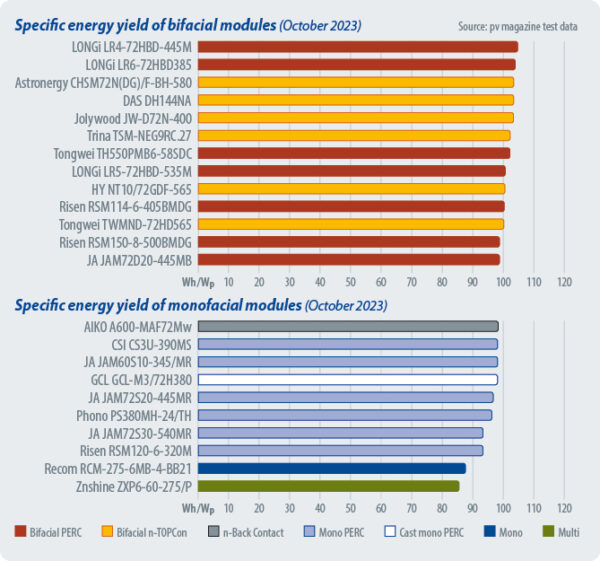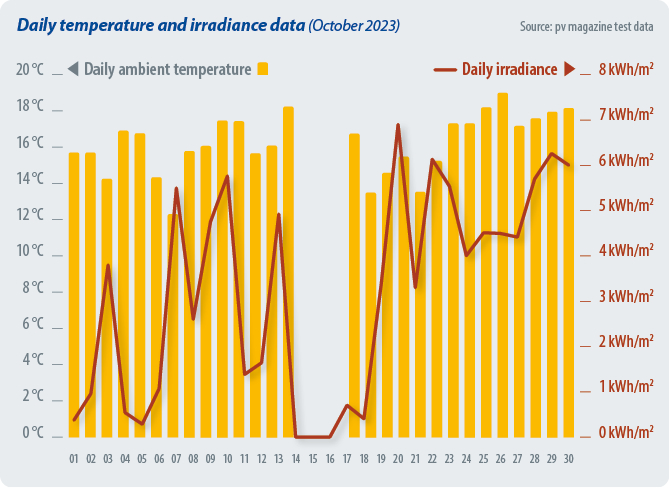The first chart, pictured above, shows the meteo station data with irradiance and ambient temperature for October 2023. Due to an issue with the collection of information, system data is missing for Oct. 14 to Oct. 16. We observed that the energy yield figures of several top-performing products are very close and this could render the numbered ranking method we have been using less meaningful. CEA is currently working on a new ranking system that will adapt to these new trends and be more representative of product performance.
The average bifacial boost was 10.20% for October 2023. Bifacial boost is defined as the relative advantage of the average specific energy yield of all bifacial products compared to the average specific energy yield of all monofacial mono passiavted emitter rear contact (PERC) products.
Bifacial boost
| All in Wh/Wp | Total Aug. 2023 | Total Sep. 2023 | Total Oct. 2023 | Total Nov. 2023 |
|---|---|---|---|---|
| Average monthly yield | 133.43 | 103.62 | 102.68 | 40.36 |
| Average monthly bifacial yield | 142.29 | 108.65 | 105.91 | 42.08 |
| Average monthly monofacial PERC yield | 129.12 | 99.28 | 100.37 | 40.20 |
| Operation days | 23 | 29 | 28 | 14 |
| Average daily yield | 5.80 | 3.57 | 3.67 | 2.88 |
| Average daily bifacial yield | 6.19 | 3.75 | 3.78 | 3.01 |
| Average daily monofacial PERC yield | 5.61 | 3.42 | 3.58 | 2.87 |
| Bifacial TOPCon boost | N/A | 10.88% | 5.74% | 5.22% |
| Bifacial PERC boost | N/A | 8.21% | 5.32% | 4.23%% |
| All technologies bifacial boost | 10.20% | 9.16% | 5.52% | 4.69% |
Specific energy yield ranking of bifacial modules – historical
| # | Installation month | Product | Type | Sample selection method | Total July 2023 Wh/Wp | Total Aug. 2023 Wh/Wp | Total Sep. 2023 Wh/Wp | Total Oct. 2023 Wh/Wp | July 2023 Rank | Aug. 2023 Rank | Sep. 2023 Rank | Oct. 2023 Rank |
|---|---|---|---|---|---|---|---|---|---|---|---|---|
| 37 | 2021/5/1 | LONGi LR4-72HBD-445M | Bifacial PERC | 3 | 137.27 | 146.60 | 111.11 | 104.81 | 2 | 1 | 2 | 1 |
| 26 | 2019/8/28 | LONGi LR6-72HBD375 | Bifacial PERC | 1 | 136.22 | 145.67 | 110.44 | 104.03 | 4 | 4 | 4 | 2 |
| 50 | 2023/9/1 | Astronergy CHSM72N(DG)/F-BH-580 | Bifacial N-TOPCon | 3 | / | / | 112.05 | 103.53 | / | / | 1 | 3 |
| 42 | 2023/6/5 | DAS-DH144NA-570 | Bifacial N-TOPCon | 3 | 139.49 | 146.49 | 110.65 | 103.52 | 1 | 2 | 3 | 4 |
| 27 | 2019/12/31 | Jolywood JW-D72N-400 | Bifacial N-TOPCon | 3 | 136.84 | 145.78 | 110.31 | 103.49 | 3 | 3 | 5 | 5 |
| 45 | 2023/8/15 | Trina TSM-NEG9RC.27 | Bifacial N-TOPCon | 3 | / | / | 109.31 | 102.35 | / | / | 7 | 6 |
| 41 | 2022/12/18 | Tongwei TH550PMB6-58SDC | Bifacial PERC | 1 | 134.44 | 140.75 | 108.40 | 102.27 | 5 | 6 | 8 | 7 |
| 38 | 2021/11/20 | LONGi LR5-72HBD-535M | Bifacial PERC | 3 | 131.15 | 139.65 | 106.44 | 100.74 | 6 | 8 | 10 | 8 |
| 47 | 2023/9/1 | HY NT10/72GDF-565 | Bifacial N-TOPCon | 3 | / | / | 110.01 | 100.66 | / | / | 6 | 9 |
| 28 | 2020/4/15 | Risen RSM114-6-405BMDG | Bifacial PERC | 3 | 130.56 | 139.89 | 106.36 | 100.39 | 7 | 7 | 11 | 10 |
| 43 | 2023/6/23 | Tongwei TWMND-72HD565 | Bifacial N-TOPCon | 3 | / | 143.57 | 108.18 | 100.29 | / | 5 | 9 | 11 |
| 32 | 2021/7/1 | Risen RSM150-8-500BMDG | Bifacial PERC | 1 | 128.76 | 137.13 | 104.54 | 98.84 | 9 | 10 | 13 | 12 |
| 34 | 2021/7/1 | JA JAM72D20-445MB | Bifacial PERC | 2 | 128.72 | 137.36 | 104.73 | 98.83 | 8 | 9 | 12 | 13 |
Specific energy yield ranking of monofacial modules – historical
| # | Installation month | Product | Type | Sample selection method | Total July 2023 Wh/Wp | Total Aug. 2023 Wh/Wp | Total Sep. 2023 Wh/Wp | Total Oct. 2023 Wh/Wp | July 2023 Rank | Aug. 2023 Rank | Sep. 2023 Rank | Oct. 2023 Rank |
|---|---|---|---|---|---|---|---|---|---|---|---|---|
| 44 | 2023/9/1 | AIKO A600-MAF72Mw | N-back contact | 3 | / | / | 104.79 | 98.47 | / | / | 1 | 1 |
| 29 | 2020/7/7 | CSI CS3U-390MS | PERC | 2 | 123.44 | 132.83 | 102.12 | 98.26 | 1 | 2 | 3 | 2 |
| 31 | 2020/10/1 | JA JAM60S10-345/MR | PERC | 2 | 121.70 | 131.09 | 101.57 | 98.25 | 4 | 4 | 4 | 3 |
| 30 | 2020/7/7 | GCL GCL-M3/72H380 | Cast PERC | 1 | 123.20 | 133.26 | 102.23 | 98.22 | 2 | 1 | 2 | 4 |
| 35 | 2021/7/1 | JA JAM72S20-445MR | PERC | 2 | 122.85 | 131.80 | 101.13 | 96.81 | 3 | 3 | 5 | 5 |
| 20 | 2018/11/21 | Phono PS380MH-24/TH | PERC | 1 | 120.72 | 130.80 | 100.39 | 96.39 | 5 | 5 | 6 | 6 |
| 36 | 2021/11/20 | JA JAM72S30-540MR | PERC | 2 | 119.41 | 127.13 | 97.98 | 93.49 | 6 | 6 | 7 | 7 |
| 21 | 2019/3/1 | Risen RSM120-6-320M | PERC | 1 | 106.27 | 116.96 | 89.54 | 93.48 | 7 | 7 | 8 | 8 |
| 10 | 2018/5/24 | Recom RCM-275-6MB-4-BB21 | Mono | 1 | 96.20 | 105.36 | 86.05 | 87.72 | 8 | 8 | 9 | 9 |
| 22 | 2019/5/4 | Znshine ZXP6-60-275/P | Multi | 1 | 93.70 | 102.95 | 84.92 | 85.56 | 9 | 9 | 10 | 10 |


Energy yield measurements:
- The energy yield comparison among various technologies, including bifacial boost, is analyzed using products installed after the beginning of 2019.
- The energy yield is given in Wh/Wp and calculated by dividing the energy produced by the module by the maximum power point (Pmax) at standard test conditions (STC) of the module. This Pmax is the maximum STC power after a process of stabilization.
- The results are grouped in categories, per module type.
- The bifacial boost depends on many parameters, such as the bifaciality factor, the installation geometry, the albedo of the ground, the sun angle, and diffuse irradiance. The ground, in this case, is gray gravel.
Test cooperation
This content is protected by copyright and may not be reused. If you want to cooperate with us and would like to reuse some of our content, please contact: editors@pv-magazine.com.
